The Rise of the Pocket Synthesizer
Whether tiny synths are an affordable route into electronic music production or disposable gimmicks, the possibility of carrying high-performance hardware in your backpack is making these small-scale machines a big noise
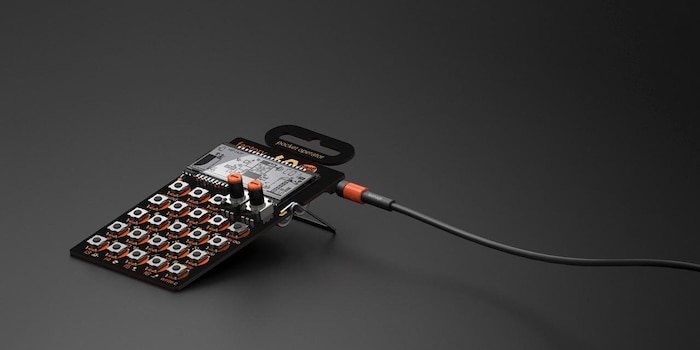
Somewhere in the 2000s, the unique voice of the analog synthesizer came back into vogue, complete with its own hashtag-able musical movement, #synthwave. In a combination of coincidence and astute business acumen, new synths, drum machines and sequencers, plus a supporting cast of mixers, amps, multi-track recorders and other peripherals started to emerge from the tech industry, all with the contemporary twist of being diminutive in stature and low in cost. Such hardware has arguably made electronic music more accessible than ever, and in turn is inspiring new approaches to music-making.
“In many ways, the proliferation of these devices is a result of thinking about how technology fits into music-making as a social human activity, and less about the technology itself,” says Owen Osborn, CEO of Critter & Guitari, manufacturers of the progressive Organelle mini-synth. “Now that the technology is so readily available people are starting to consider more fun and exciting ways to make music with it.” It’s a point readily observable in the increasing trend of “synth jams,” online video that exhibits an extreme bias towards the usage of miniature equipment. Distributed via social networks, it’s a democratic landscape where keen users – amateurs, professionals and manufacturers alike – share footage and commentary of their extensive small-scale set-ups and the music that it empowers them to make, usually compositions of a free-form, improvisational and experimental manner, which might have previously been the realm of traditional instruments.
The goal of portability makes the invention of the pocket synth seem like less of a surprise and more of an inevitability.
In the technology industry, the unwritten law has always been that smaller is better. It’s plausible that this derives from an in-built human need to carry our things around with us, and that drive certainly extends to musicians. Peter Kirn, the founder of Meeblip, manufacturers of the Triode, agrees: “Having something small can allow you to travel with your music. And sometimes it’s what you need to be inspired and feel creatively free.” Indeed, looking at the historical development of the synthesizer, the goal of portability makes the invention of the pocket synth seem like less of a surprise and more of an inevitability.
The first instruments to explore audio synthesis were monolithic contraptions. Synthesizers might seem like a modern product, but in fact the developmental seeds were sown somewhere back in the 13th or 14th centuries with the pipe organ, an invention which, rather than flowing an electric charge through different circuits, achieved its version of sound modulation by blowing air though adjustable banks of tubes. The first electric instruments to explore the same theories came around in the late 1800s with the Musical Telegraph, around 1876, or the Teilharmonium around 1896, and although both were smaller than the standard organ, moving them around was still out of the question. By the 1930s the first properly transportable instruments, like the Hammond organ, had arrived, but it wasn’t until the early 1960s that a major development in portable audio synthesis came to pass.
The emergence of transistor technology inspired German engineer Harald Bode to write an academic hypothesis that posited the notion of a fully portable electronic sound generator. Though a theoretical exercise, significantly for musicians, the thinking was taken on board by a couple of American engineer going by the names of Buchla and Moog. Accordingly, the first of what could be described as being truly “pick up and play” instruments came with the Minimoog Model D and the Buchla Music Easel, both released in 1972. Their relative ease of use and affordability created an explosion in synthesizers heard across all genres of recorded and performed music, from rock to classical to easy listening, bringing audio synthesis out of the science labs and into the public sphere.
At this point in the timeline that well-trodden technological dictum, Moore’s Law, becomes more evident. In 1965 the co-founder of Intel, Gordon Moore, observed that the number of transistors in a dense integrated circuit was doubling about every two years. It’s a rule that has stood for 50 years and has has reflected the miniaturisation across all types of technological products, not least the synthesizer.
In the late 1970s, a truly seismic shrinkage event occurred with the introduction of the Sony Walkman, a consumer product that changed society’s relationship with electronic devices forever. As people got used to carrying their music around with them, so synths went small-scale. Experiments in recreating FM synthesis digitally had been going on throughout the 1970s, with the first commercially available digital synthesizer being the Casio VL-1 in 1979. While a cheap hand-held machine that became a staple of 1980s children’s bedrooms across the globe, it nevertheless boasted features such as a memory patch, 100-note sequencer and two modulation options. By 1990, technology had advanced enough for the Yamaha QY10 “Walkstation” to be able to fit an eight-track sequencer, 32-voice polyphony and 52 instruments in one tiny battery-powered box.
Roland had also experimented with reducing the footprint of their core products. The 303
Then, by the late 1990s, hardware seemed to disappear entirely. Digital audio workstations had been around since the late 1970s, but computers largely didn’t have the processing power to make them a viable concern. It wasn’t until the late 1980s that Macs, Amigas and Atari STs made DAWs as we now know them possible, supporting platforms like SoundEdit, SonicSystem and a small contender known as Pro Tools. DAWs introduced the concept of Virtual Studio Technology, AKA VSTs, software plug-ins which emulate studio hardware instruments. It is precisely when these started to become extractable from the DAW environment as an app – in most cases skeomorphed to look like their hardware counterparts – that you can witness the irony of digital devices essentially becoming standalone instruments. According to synthwave artist Morgan Z, AKA Chrome Canyon, a keen hardware user who also makes extensive use of VSTs, “Because the iPad is a touch interface it’s the next best thing to having real knobs. Also, with a dock that supports 1/4-inch out it’s basically like having a little synth in your backback.”
These digital recreations informed some part of the umbrella concept of the pocket synth. Around 2010, major industry players and small start-ups alike seem to have had the simultaneous brainwave that the popularity of VST apps might mean that people would be interested in buying micro-scale hardware, tools that retained the ultra-portability and ease-of-use of app-based instruments, but achieved their sound via the tactile, real-life, real-time analog means. “By the noughties, there was a sense of rebound from the all-in-the-box, plug-in paradigm and most hardware synths were too complicated,” says Tatsuya Takahashi, then Chief Engineer at Korg. “So I felt a need for people to have real hardware that had simple functions and sounded great.”
Takahashi went on to develop the Monotron, one of many instruments to subsequently explore synth miniaturisation. Whilst they differ in their approaches, all are unified in that they are capable of creating, modifying and combining tones out of the box, either via true or digitally recreated virtual analog synthesis, just like their full-size relatives. To understand the pocket synth field more clearly, it’s worth taking an in-depth look at some of the leading and intriguing offerings currently on the market.
Tasting Notes of Tiny Synths
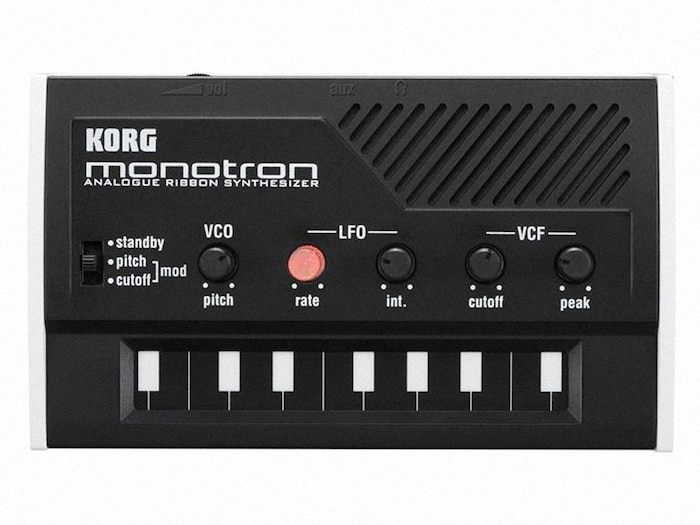
(Released 2010)
These are probably the default instruments in the product bracket of pocket synths. The first on the scene, they are undoubtedly the most ubiquitous in the field. Informed by the maxim “Go Anywhere Analog,” the Monotron Duo and Delay were kept deliberately “no-frills,” as Tatsuya Takahashi explains: “The whole compact instrument idea came about from trying to make electronic instruments as simple and as accessible as something like a guitar. It’s extremely simple in that you have strings that you can change the resonant frequency of by changing the effective length. The aim of the Monotron was to allow this kind of freedom and for that they needed to be simple.” Essentially shrunken versions of a full-size ’70s synth, as their on-body graphics suggest, the Monotron line plays the retro card heavily. Based on the same external architecture of miniature ribbon keyboard and five controllers, underneath the hard plastic casing all three have a similar juxtaposition of vintage and new elements. According to Takahashi, “The designs were a combination of adapted old circuit designs, like the MS-20 filter in the Monotron, plus new elements. For example, the Delay has the original MS-20 filter topology, but a brand new LFO design.” With an internal speaker and headphone jack, they can be played as a self-contained instrument, or using audio-in they become effects units for other instruments. “We didn’t design for a particular target, only for a particular experience,” says Takahashi. “If you can have a really fun synth experience with it, I’ve done my job. It’s up to the musician whether they want to use it live, record it or sample it to use in a production or just doodle with it on the couch.” An extra bonus is that their circuit schematics are published online so that anyone with the will can tweak the circuitry. As Takahashi concludes: “The thing about modding stuff is that you can make it your own, it becomes unique and personal. People do it to guitars all the time, so why not synths?” Korg
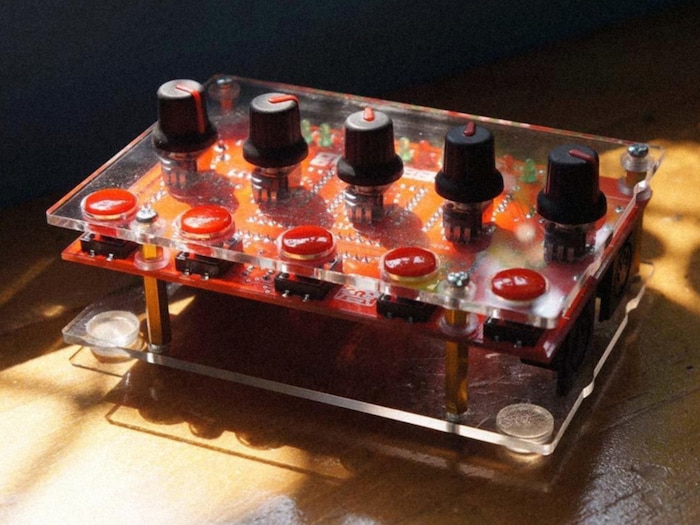
(Released 2017)
The Groovesizer RED is a kit-based product intended for first-time builders, created by the one-man company/recording artist MoShang, AKA Jean Marais. One of the lesser-known pocket synths, it’s worth a mention not just because of its eye-catching design, but because it offers an incredible amount of features in such a small package. “My overarching goal is to create instruments with a unique voice that I find personally useful,” says Marais, “and to leave enough information out there and comments in my code that a user who is motivated and interested can retrace my steps.” The RED is built on the Arduino OS because, according to Marais, “I built a Shruthi-1 kit by Mutable Instruments and caught the DIY music electronics bug. I decided to design a PCB that could be reconfigured easily to try out some of the Arduino audio projects that were available around the web.” Its usage on the RED is intended as educational as well as functional: “There’s a vast amount of information available around the web for the Arduino platform, and the hope is that anyone who is interested in learning can get an easier start.” Aside from a 16-step MIDI sequencer, the RED offers a deceptively large amount of parameter options across its five controllers. With MIDI functionality for triggering patterns and keying notes, it is another pocket synth that has a lot of potential to go beyond amateur noodling and into professional recording and performance. As Marais concludes, “Clearly some instruments are designed with professional use cases in mind – some by offering connectors that are more useful in the pro context, or by using only premium quality components. My instruments are not designed with those parameters in mind, but I believe any instrument that is unique-sounding enough can find its way into a pro production.” MoShang
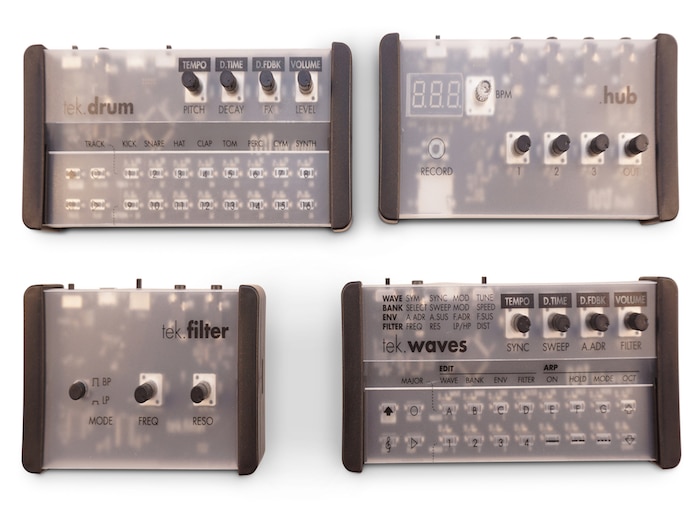
(Released 2017)
Minijam Studio is the Kickstarter-funded brainchild of German/Irish collaboration Mindflood, following comments on their own Patchblocks modular pocket synth system. “We received the feedback from our customers, that they would like to have something that works out of the box and doesn’t involve a computer,” says CEO Sascha Goetz.“We did a lot of research and development and still tried to follow the path of keeping it entry level, but still to create something powerful.” Developed over a year, the result is essentially a workstation device broken down into separate modules. The intention was to keep in mind affordability, so the team kept an eye on the component market and eventually decided to design everything from scratch – which seems to have paid dividends. Although the units and controls are borderline microscopic, the synth and drum machine are packed with features more common to mid-level equipment, with the analog filter unit offering offering additional parameter adjustments. A unique addition is a three-channel mixer with the smart innovation of a sync trigger that uses the same socket as the audio-in, splitting the mono channels between the instrument and mixer. You can also export WAV via the microSD slot. Patchblocks/Mindflood Ltd.
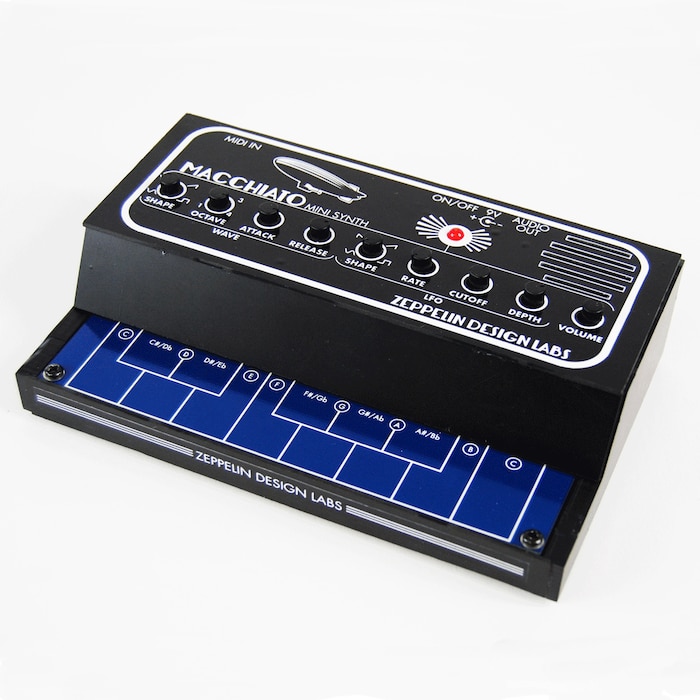
(Released 2017)
As Glen van Alkemade of Zeppelin Design Labs explains, the decision to go small-scale was circumstantial: “In summer 2016 we took on an intern who was studying computer and electronics hardware. He knew all about microcontrollers; we did not. While we had him, we decided to develop a micro-based product so we could benefit from each other’s resources. We settled on a mini-synthesizer, the Macchiato.” Van Alkemade says that the intention “was to reach primarily the amateur DIY music community: hackers, noodlers, experimenters.” In development for six months, the results opt for a “shrunken synth” look, but despite the retro cardboard casing and branding the Macchiato is decidedly new school. Its sounds are built on Arduino software, with a variety of patches onboard at point of purchase. (Sounds can be updated or hacked offboard and then re-uploaded via ISP.) It is playable via a touch-sensitive, polyphonic printed keyboard. Sound parameters are adjustable across eight controllers, split into two sections of waveform and LFO. Boasting a MIDI-in, the Macchiato can be also be used as a pure sound unit, controlled by external controllers. The Macchiato is available pre-built but mainly shipped as a kit because of a personal belief of product designer Brach Siemens: “One of my main goals in this business is to empower people to build their own music gear. We offer all of our products as kits that our customers can build themselves. Most musicians don’t have a clue how their electronic instruments work; most people just view them as a mysterious black box that ‘does something.’ I believe that everyone should have at least some concept of what’s inside the gear they use, and if possible, have a hand in creating it.” Zeppelin Design Labs (c) 2018
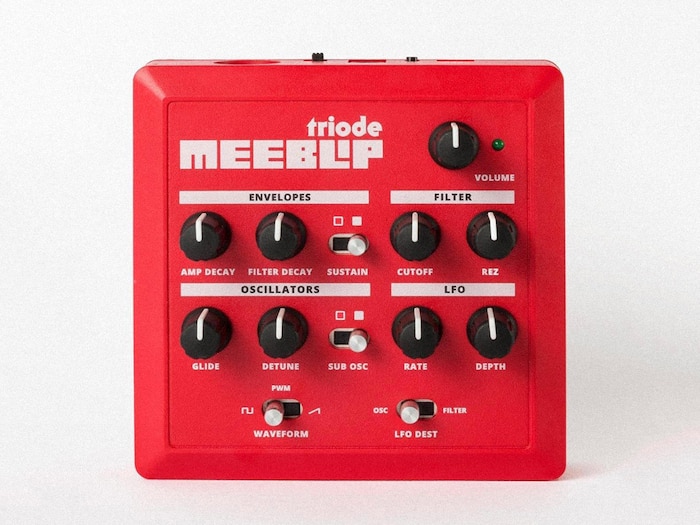
(Released 2017)
According to Peter Kirn of Create Digital Music, “The MeeBlip grew out of conversations between me and engineer James Grahame, who’s based in Calgary, Canada… It turned out we shared a passion for making an instrument that was affordable, hands-on and open.” Although this synth is full-sized, it just happens to be a small red box, which was very much the intention. “Synths don’t have to be complicated and expensive to be expressive,” says Kirn. “I think there’s something wonderful about picking up a synth and having it be small and affordable and daring you to play it.” Indeed, the Triode is very much geared towards being a highly portable performance instrument. Its interface looks as if someone unbolted a module from a modular rack, with a straightforward and clear layout. Built on a virtual analog three-oscillator system it mixes digital waveforms and analog filters. The Meeblip also has many hidden parameters that can be accessed via methods other than the onboard controls. For example, you can change wavetable banks by switching firmware when you power up. Interestingly, the Triode also has a filter drawn from an outside source: “James looked to a classic 1970s guitar pedal circuit and had the novel idea of applying it to a synth,” says Kirn, a move which gave the synth some heavyweight punch and earned it popularity with users like Octave One, who say “We choose the Meeblip because in its size and weight class, nothing sounds as thick and as analog, although it’s digital.” Anastasia Muna
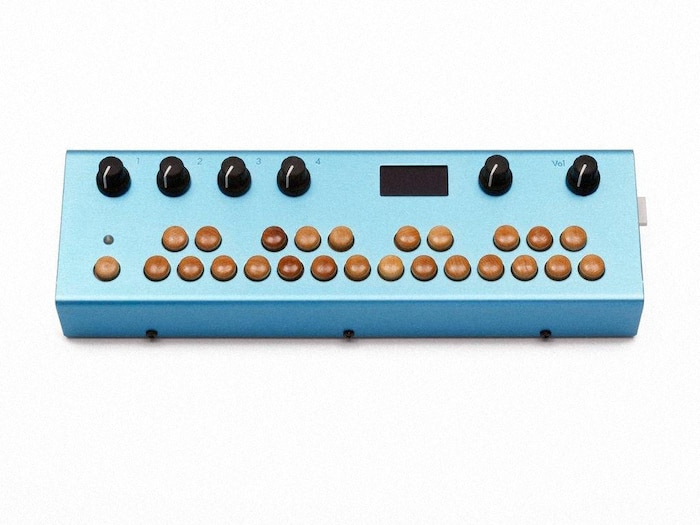
(Released 2016)
The most expensive instrument in this selection, the Organelle had a long development time. According to designer Owen Osborn, “mostly we were waiting for the components to get powerful and affordable enough to make it happen.” It is arguably the only pocket synth that is fully pointing to the future rather than keeping a foot in the past, as Osborn contends: “We wanted to combine the immediacy of a traditional instrument with real-time programming. Something that you can pick up and start playing or programming or something in between, and discover new ways to interact with sound and music processes.”The result is quirky and minimal, mixing polished wood and brushed aluminium to create a vision of what we might expect a musical instrument of the future to look like. (The sole nod to the past is the usage of rotary knob controllers.) Based on the physical design of C&G’s Pocket Piano series, the Organelle goes further to work as a synth, drum machine, sampler or effects processor. Playable out of the box, users can also edit these preloaded patches or create new ones, either directly on the machine or externally on a PC to load in via USB. As is becoming the norm, the Organelle is 100% customizable. “If you want to explore the programming side of things it is also a great starting point, and being open-source you can go as deep as you like,” says Osborn. Critter and Guitari
.61f77285.jpg?auto=format&w=700)
(Released 2015)
These are the synth deconstructed – visually, at least. Out of all the products on the market, these look the least familiar, which might be expected from a collaboration between an audio technology company and a fashion brand. Teenage Engineering made their name with the OP-1, an expensive but popular self-contained, small-footprint synth workstation (although one that is still too big to be a pocket synth). As TE’s Head of Education Tobias von Hofsten says, “A common reaction to OP-1 in the beginning was that, ‘It’s really cool, but I want something bigger.’ After a while we brought out the Pocket Operators. The products are backpack compatible and allow for music-making everywhere. An app can be cheap, fun and incredibly powerful, however one still needs a physical device to access it.” Whereas others have opted for beautiful builds to tackle the competition of app-based instruments, Pocket Operators jettison the niceties of outer casings in favor of for pure functionality. “The user is getting a direct relation to the machine itself, invoking emotional attachment and promoting creativity within limitation,” says von Hofsten. Whether a limitation or not, each model in the series of nine (including a lead synth, a bass synth, two drum machines, three noise generators – office, robot and arcade – and two samplers) uses synthesized or sampled sounds, or a combination of both, and is built on a consistent physical blueprint: circuit board, 23 buttons, two controllers and an LED display which, controversially amongst users, largely serves a decorative purpose, depicting whimsical animations as opposed to practical data readout. Patterns are recorded into the onboard step sequencers to generate loops or full songs, but they can also be played live over the top of sequenced patterns, with effects tweakable in real time either on individual sounds or globally. Teenage Engineering/Cheap Monday
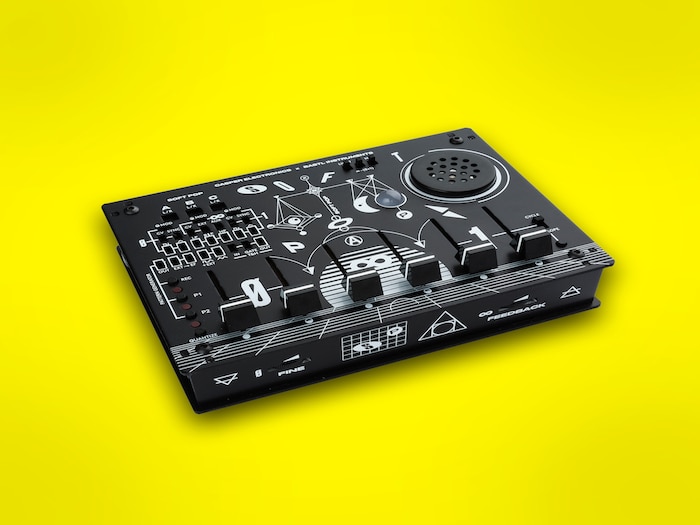
(Released 2017)
Although the softPop is only loosely a pocket synth, the option to add a carrying handle merits its inclusion in this list. Moreover, it is notable as a transition instrument that moves the pocket synth concept into a generally more “serious” product bracket and because it is made by the company with a reputation as market leaders. As Bastl say themselves, the softPop is intended as a “playfully organic, semi-modular light and sound synthesizer with a wide variety of sounds,” and that “battery operation, built-in speaker and carrying handle make it the ultimate picnic boombox.” Dominated by six faders and a heavyweight aluminium enclosure, it looks more like a DJ mixer at first glance, until you notice the onboard speaker and bay of miniature patch inputs, which highlight its potential use as a powerful, two-oscillator subtractive synth. One fan of the softPop is artist and producer Pete Kember, who remarks that “There is a great history of people putting lower-price equipment in strong, serviceable casing. Bastl stuff is a nice implementation of something essentially in miniature, but still with decent housing.” He continues to say “an instrument is 50% how it sounds and 50% how it feels to use & play,” which is something that, press release rhetoric aside, the softPop clearly pays a lot of attention to. Beyond the user interface, it offers the option to be plugged into other modular synths, and can also process incoming audio synchronized with the rhythm of the incoming signal. Ondrej Krchnak
What does the pocket synth mean for the future of electronic music-making? As humans can already inject themselves with medical robots, might the future of electronic music be a William Gibson-esque landscape, where synth-sympathizers can bypass any need for hardware or software by injecting instruments directly into their brains? It’s a tantalizing and possibly terrifying vision, but one that most likely will stay science fiction. Although electronic music sets us free from the physical constraints of acoustic music, at some point similar restrictions apply. Once upon a time, circuit boards had to be a certain size due to the need to solder connections, but printed boards got rid of that. Now we have powerful synths the size of a calculator, but their very existence demonstrates that we still want or need to interface with something physical.
The whole point of a synth, whether large or small, analog or digital emulation, has always been the fact they are not a static instrument, as celebrated synth pioneer Suzanne Ciani explains: “As a composer, I love the fact that I can interact in real-time with a modular instrument, in my case a Buchla 200e, and create and sculpt sound compositionally. The modular allowed a completely immersive experience and was intuitive and poetic. It was a parallel universe to acoustic music and I didn’t want to cross them with each other. Thus, no keyboard. It was about the way sound could move more than about a particular sound.”
One often-heard criticism of pocket synths, however, are their limited features, as Detroit production duo Octave One, keen users of Meeblip products, noted. “Most professional recording artists we know can use just about anything to record, but not choose too because of a variety of reasons. Many micro-scale units may not have the features a pro might desire or the quality of the sound may not be up to what is expected. Sometimes those small audio connections can themselves be a big turn-off.”
Despite this, many artists celebrate the limitations that come with synths in small sizes, tiny interfaces and all. As Chrome Canyon puts it, “I think anything can become a music-making device. Kraftwerk showed us that really early on... and lots of people since have been using toys and other low-priced things to create unique sounds and music – so I really think it’s in the process of how things get used. But the idea of creating sound generation devices that are affordable to young kids and people that don’t have too much cash to burn seems like a great thing to me.”
Pocket synths also continue the full-size tradition of standardised connectivity, allowing products from different firms to be playable with each other. Units from different originators with different intentions openly bring quirks in their sound and playability to the table, allowing users to mix and match according to taste preference so that the result, albeit miniature, is a truly personal set up, which for Suzanne Ciani can “provide an introduction to the concept of electronic music.” But, as she observes, “I think there’s also a hunger for more sophisticated instruments, but those instruments are not so easily accessible to everyone who would like to get their hands on them. Eventually, some of the companies that make the smaller instruments will want to develop the more sophisticated instruments and that will take us all to the next level.”
Even these valid criticisms, though, don’t detract from the overall impact of pocket synths. They’ve been another vital addition to the continuing story of synthesizers, enabling new ways of thinking about sound generation, user interface and, perhaps most importantly, what we do with them. Their scale reduces the barrier of entry for electronic hardware, and in turn encourages playful experimentation in many ways distinct from what comes from working with full-size, “professional” synthesizers. The influential artist and producer Pete Kember, AKA Sonic Boom of Spacemen 3, is a keen user of pocket synths and considers their impact similarly. “Anything that makes a sound is a viable source, and ones that are easily modifiable – that’s a fantastic universe in itself. He goes on: “Some of my favourite artists today are ‘part-timers’ – amateurs. But that phrase really belies what they convey in their music, and often exceeds the depth of many so-called professionals.” It could be that the real importance of the pocket synth is not simply what they sound like, but rather how they might lead us toward redefining the meaning of musicianship in the 21st century.

